It’s not magic, it’s physics
Musical Magnetism program makes STEM fun, approachable

Photo by Noelle Laghmam--Eighth-grade students at Franklin STEAM Academy watch as University of Illinois Physics Professor Nadya Mason submerges carnations in a canister of liquid nitrogen in the Champaign middle school’s library. Mason conducted several fun, interactive experiments demonstrating how properties of materials change when they get very cold as part of this year’s Musical Magnetism program.
Jan 26, 2022
Recently, some Franklin STEAM Academy students walked into their library and discovered that a section had been turned into a physics lab.
On one side of a table were two glass beakers, a tall silver cylinder, and some safety equipment. And on the other side was a magnet, about the size of a hockey puck, floating and spinning above another magnet. “What the …,” a seventh-grade student said, incredulously, upon spying what he later learned was a superconductor.
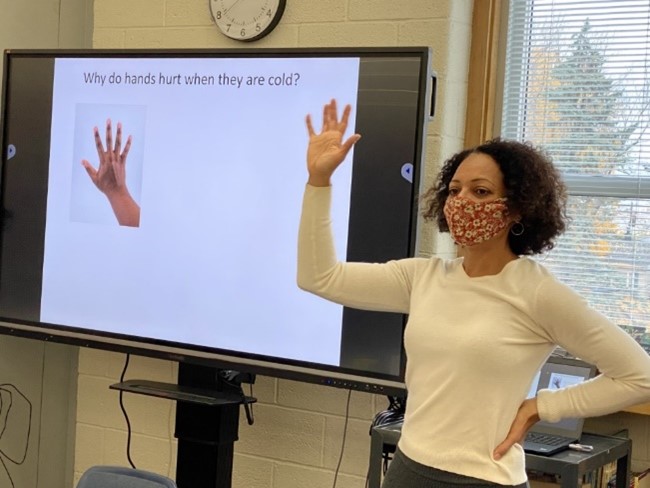
Photo by Noelle Laghmam--Mason explains to students that when their hands get cold, the fluid in the joints of their hands slows down, making their hands less effective and sometimes causing a painful sensation.
Before the student could finish, guest speaker Nadya Mason introduced herself and the day’s lesson. “Today, we’re going to look at what happens when materials get cold. What happens is extraordinary,” she said, piquing their interest. Mason is a Rosalyn Sussman Yalow Professor of Physics at the University of Illinois and director of the Illinois Materials Research Science and Illinois Materials Research Science and Engineering Center (I-MRSEC) on the Urbana-Champaign campus.
On Nov. 15, Mason and Pamela Pena Martin, I-MRSEC’s outreach coordinator, were at the Champaign middle school as part of the Musical Magnetism program, which Mason heads.
Now in its third year, the Musical Magnetism program is a collaboration between I-MRSEC and the academy, funded by the National Science Foundation (NSF).
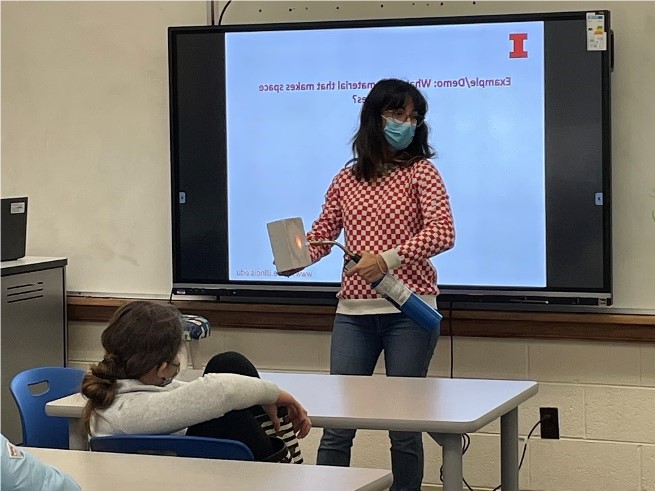
Photo by Zanne Newman, Franklin STEAM Academy site coordinator—Associate Professor Cecilia Leal (MatSE) introduces students to what materials science during her visit to the school on Oct. 28, 2021.
During the program, guest scientists –members of an interdisciplinary team of faculty and graduate and post-doctoral students—introduce seventh- and eighth-grade students to STEM concepts and show them how those concepts can be expressed through artistic endeavors. While those endeavors focused mainly on music the first year, they were expanded to writing, poetry, drawing, and sculpture last year when the program was held virtually due to the COVID-19 pandemic. “We found that they really resonated with students,” Pena Martin said of the expanded art forms.
The seven-week-long curriculum—presented mostly in person this year—includes lessons on magnetic materials, materials and light, electronic materials, ancient materials, and engineering with materials delivered through fun, interactive demonstrations, and hands-on activities. For example, following lessons on magnetic activity by Daniel Shoemaker, an associate professor of materials science and engineering, and uses for magnetic materials by Fahad Mahmood, an assistant professor in physics, students got to take apart a Magna Doodle and see the tiny, magnetic particles so that they could better understand how magnetism and the toy work.
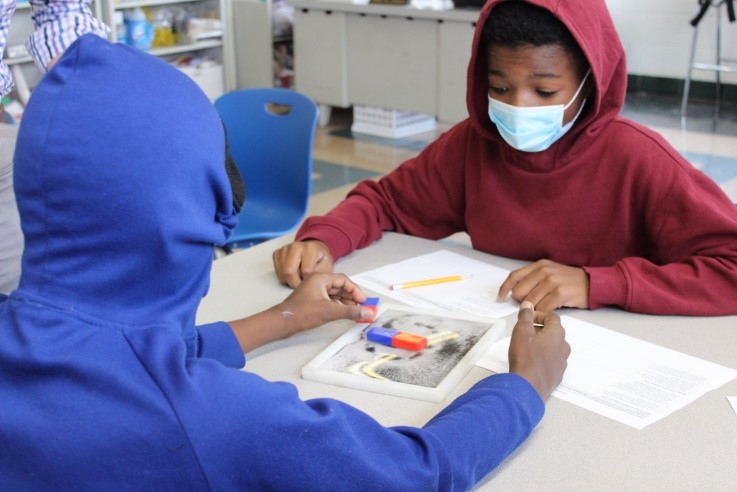
Photo by Zanne Newman—Franklin STEAM Academy students participate in an activity demonstrating how magnetism works.
The program culminates with a presentation of students’ final projects, which in past years, have included hip hop rhymes and dance, Haiku, and comics, illustrating their understanding of a materials science concept and creativity.
Mason said the program aims to make STEM more approachable to students by providing them with authentic opportunities outside of the classroom and building confidence in their abilities.
“It’s also showing them how science connects with the things they’re interested in and interact with on a daily basis,” she said. Hopefully, Mason said, that will spark students’ interest in STEM, particularly females and other underrepresented groups in STEM fields, and encourage them to take STEM courses in high school and college and pursue a STEM career.
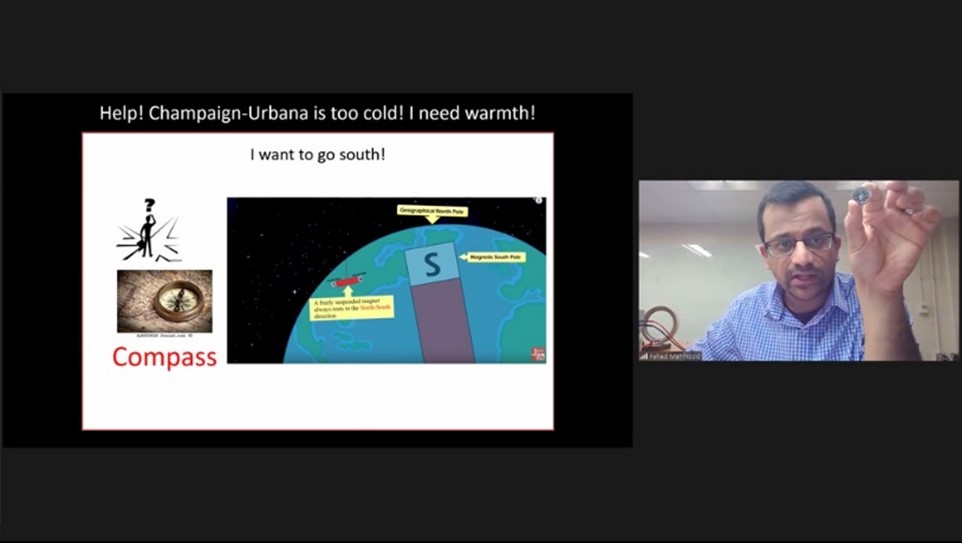
Photo by Pamela Pena Martin—Assistant Professor Fahad Mahmood (Condensed Matter Physics) explains how a compass works during a Nov. 4, 2021 virtual presentation on uses for magnetic materials.
Back in the Franklin Academy library, Mason told students that she leads a lab of 10 students, where they research the electronic properties of very small (10 -9 meter) systems—or materials such as carbon nanotubes, graphene, topological insulators, nanostructured superconductors, and other novel 1D or 2D systems, according to her research statement.
“That’s a million times narrower than a strand of hair,” she said, before asking students to identify items with tiny parts that they use or are familiar with.
“A computer,” a student offered. “A smartphone?” another questioned.
“Yes!” Mason answered.
“Those things were brought to you by physicists,” she added, proudly. “We study the properties of these materials that give you the electronic devices that we have today and that we’ll have in the future.”
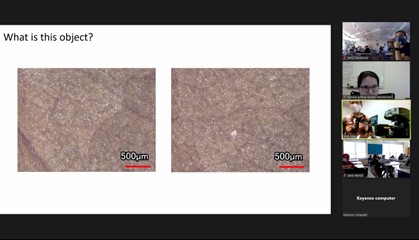
Photo by Pamela Pena Martin—Dr. Kathy Walsh, a senior research scientist at the Materials Research Laboratory, shows students how an optical profiler works during a virtual demonstration on Nov. 8, 2021. Walsh then shared a Haiku about one of her experiments.
Mason went on to say that researchers can study the properties of materials by making them very cold.
“What do you feel when your hand gets cold?” she asked, holding hers up. “It feels like someone is sticking needles in your hand.”
She explained that we have fluid in the joints of our hands, which helps them move. So when our hands get cold, the fluid moves more slowly, making our hands less effective and causing the painful sensation.
“So, our hypothesis is particles (molecules and atoms) move more slowly when they’re cold,” said Mason, who tested it by running a few experiments.
First, she dropped red dye into a beaker of steaming hot water and blue dye into a beaker of ice-cold water. Students watched as the dye immediately turned the entire beaker of hot water a brilliant red, but the blue dye stayed suspended in the center of the cold water.
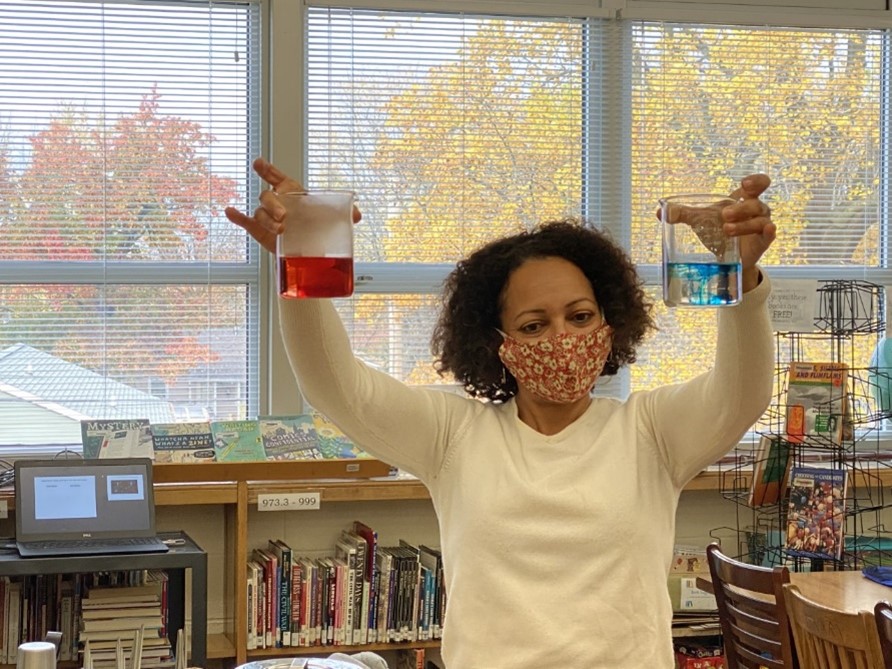
Photo by Noelle Laghmam - Mason holds up two beakers of water, demonstrating to students what happens when dye is dropped into steaming hot water and a frigid cold water.
“Our hypothesis was correct,” Mason said.
Next, she held up a rubber band and stretched it. After donning safety goggles and gloves, she used tongs to submerge it into a canister of liquid nitrogen, -200 degrees F, causing white steam to roll out of the top. After lifting it out, she tapped the rubber band on the table, causing it to break apart. Students gasped.
Mason explained that rubber stretches when molecules move past each other and straighten out. But when it freezes, the molecules can’t move around, and it becomes brittle and breaks if someone tries to stretch it. “When it warms up, it’s stretchy again.”
Then, Mason called students up to the table to run the experiment on carnations with pink- and yellow-tinted petals. After submerging them in the liquid nitrogen, she handed them to students. When students smacked the flowers on the table, their petals shattered.
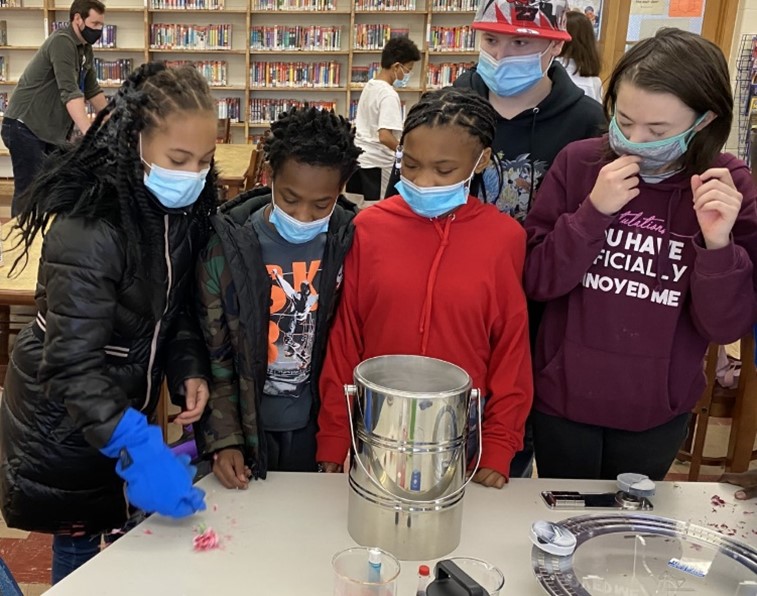
Photo by Noelle Laghmam—Mason gives students carnations that she’s dipped into a canister of liquid nitrogen to see what happens to the flowers when they get cold.
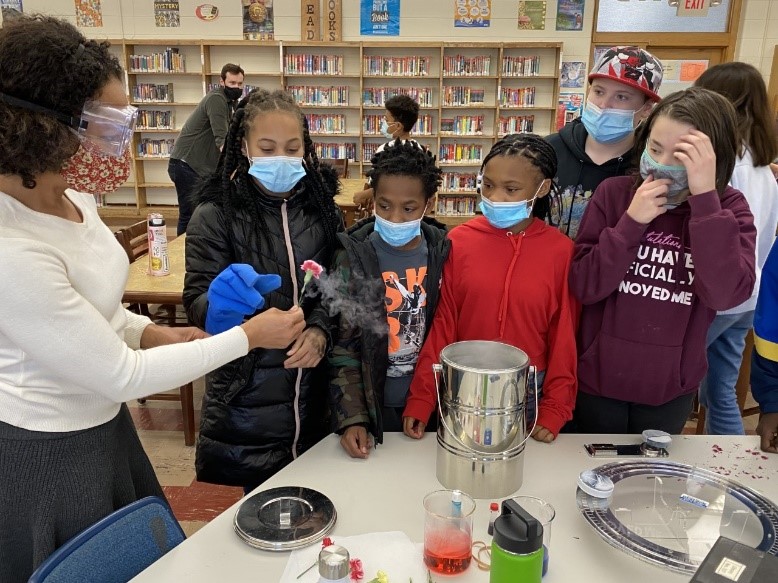
Photo by Noelle Laghmam—A carnation that was dipped in liquid nitrogen shatters when a student smashes it on a table.
“And that was a physics experiment,” said Mason, who encouraged students to experiment with other materials at home. “Try putting a banana in the freezer. If it gets hard enough, it will break when you hit it against something.” That’s just one property of materials, Mason said.
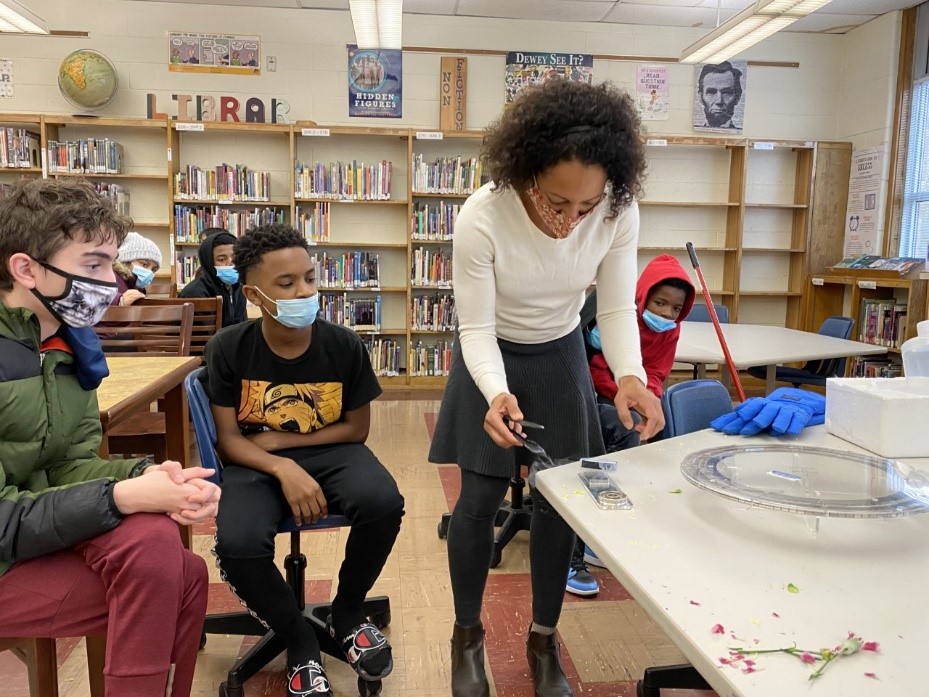
Mason holds up two beakers of water, demonstrating to students what happens when dye is dropped into steaming hot water and a frigid cold water.
In her research, “we care about what happens to electronic properties when materials get cold.” To show what happens, she used tongs to place a disc-shaped magnet that had been sitting in liquid nitrogen on top of another magnet.
“This is a superconductor,” she said, as students watched it levitate above the other magnet.
Students “oohed” and “aahed” when Mason placed another superconductor on a circular magnetic track, and it levitated around the track.
Mason explained that superconductors are materials that have no electrical resistance when they’re cooled to very low temperatures.
“This happens because the electrons slow down enough that they can pair up and flow in a new way,” she said, adding the perfect electrical currents allow superconductors to repel magnetic fields and thereby levitate. “There’s nothing holding that up.”
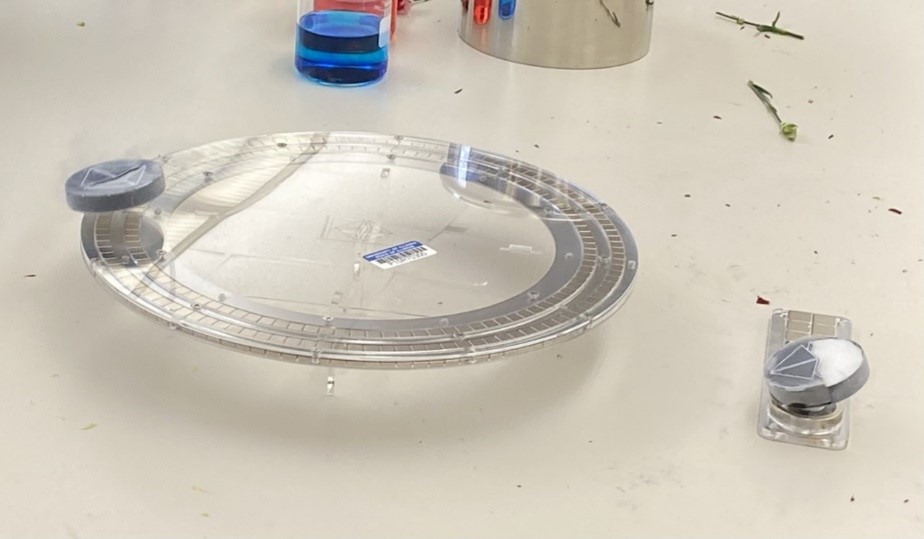
Photo by Noelle Laghmam—Superconductors, magnetic discs that were sitting in liquid nitrogen and therefore, have no electrical resistance, “levitate” above a magnet and a magnetic track.
“It’s magic,” a student exclaimed.
“It’s physics,” Mason said, before adding, “It’s not just physics. It’s amazing physics.”
Katie Lessaris, an eighth-grade science teacher at Franklin, said the Musical Magnetism program not only reinforces students’ understanding of concepts that they learned through the middle school’s science curriculum.
“It’s also exposing them to many other areas of science and the understanding that science isn’t just about being in a white lab coat,” Lessaris said.
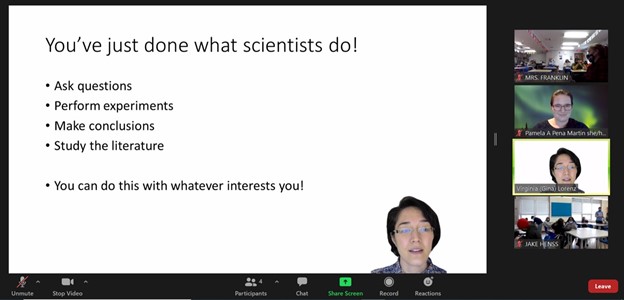
Photo by Pamela Pena Martin—Associate Professor Virginia Lorenz (Atomic, Molecular, and Optical Physics) tells students that they have taken the same steps a professional research scientist would to conduct an experiment during her Nov. 12, 2021 virtual lesson and project on how materials interact with light.
“I think it helps them see that science is all around them, and that it’s usable and applicable to their lives,” she continued. “Another cool thing is it blends science with other subjects – art, writing, history. It allows them to see there are many other ways they can explore science and STEM.”













.jpg)
















